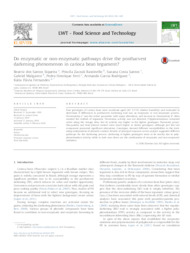Do enzymatic or non-enzymatic pathways drive the postharvest darkening phenomenon in carioca bean tegument?
Do enzymatic or non-enzymatic pathways drive the postharvest darkening phenomenon in carioca bean tegument?
Autoria: SIQUEIRA, B. dos S.; BASSINELLO, P. Z.; SANTOS, S. C.; MALGARESI, G.; FERRI, P. H.; RODRIGUEZ, A. G.; FERNANDES, K. F.
Resumo: Four genotypes of carioca bean were accelerate aged (40 0C/75% relative humidity) and evaluated to determine if differences in postharvest darkening trait was an enzymatic or non-enzymatic process. Chromaticity a* was the colour parameter with major alterations, and increase in chromaticity b* often masked the reddish of tegument. Peroxidase activity was not detected. Polyphenoloxidase remained active along the storage time, but its activity was higher in the lighter genotypes. Flavonoid, proanthocyanidin and total phenol content were much higher in darker genotypes, although just this last component presented significant alterations. Genotypes showed different susceptibilities to the darkening independent of phenolic content. Results of principal response curves analyse suggested different pathways for the darkening process: darkening in lighter genotypes seem to be mostly due to polyphenoloxidase activity while in dark ones there are the combination of enzymatic and non-enzymatic oxidation.
Ano de publicação: 2016
Tipo de publicação: Artigo de periódico
Unidade: Embrapa Arroz e Feijão
Palavras-chave: Beans, Color, Cor, Feijão, Oxidoreductases, Phaseolus vulgaris, Principal response curves, Total phenolics
Observações
1 - Por padrão são exibidas publicações dos últimos 20 anos. Para encontrar publicações mais antigas, configure o filtro ano de publicação, colocando o ano a partir do qual você deseja encontrar publicações. O filtro está na coluna da esquerda na busca acima.
2 - Para ler algumas publicações da Embrapa (apenas as que estão em formato ePub), é necessário ter, no celular ou computador, um desses softwares gratuitos. Sistemas Android: Google Play Livros; IOS: iBooks; Windows e Linux: software Calibre.
Acesse outras publicações
Acesse a Base de Dados da Pesquisa Agropecuária (BDPA) para consultar o acervo completo das bibliotecas da Embrapa.

